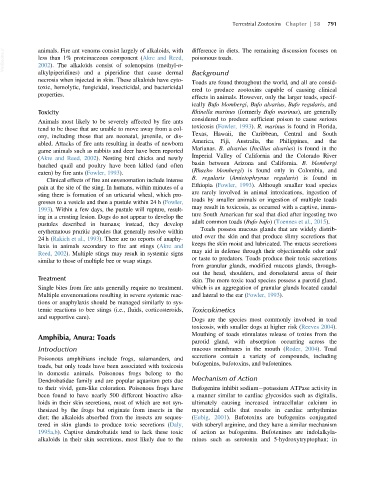Page 833 - Veterinary Toxicology, Basic and Clinical Principles, 3rd Edition
P. 833
Terrestrial Zootoxins Chapter | 58 791
VetBooks.ir animals. Fire ant venoms consist largely of alkaloids, with difference in diets. The remaining discussion focuses on
poisonous toads.
less than 1% proteinaceous component (Akre and Reed,
2002). The alkaloids consist of solenopsins (methyl-n-
alkylpiperidines) and a piperidine that cause dermal Background
necrosis when injected in skin. These alkaloids have cyto-
Toads are found throughout the world, and all are consid-
toxic, hemolytic, fungicidal, insecticidal, and bactericidal
ered to produce zootoxins capable of causing clinical
properties.
effects in animals. However, only the larger toads, specif-
ically Bufo blombergi, Bufo alvarius, Bufo regularis, and
Toxicity Rhinella marinus (formerly Bufo marinus), are generally
considered to produce sufficient poison to cause serious
Animals most likely to be severely affected by fire ants
tend to be those that are unable to move away from a col- toxicosis (Fowler, 1993). R. marinus is found in Florida,
Texas, Hawaii, the Caribbean, Central and South
ony, including those that are neonatal, juvenile, or dis-
America, Fiji, Australia, the Philippines, and the
abled. Attacks of fire ants resulting in deaths of newborn
Marianas. B. alvarius (Incillus alvarius) is found in the
game animals such as rabbits and deer have been reported
Imperial Valley of California and the Colorado River
(Akre and Reed, 2002). Nesting bird chicks and newly
basin between Arizona and California. B. blombergi
hatched quail and poultry have been killed (and often
(Rhaebo blombergi) is found only in Colombia, and
eaten) by fire ants (Fowler, 1993).
B. regularis (Amietophrynus regularis) is found in
Clinical effects of fire ant envenomation include intense
Ethiopia (Fowler, 1993). Although smaller toad species
pain at the site of the sting. In humans, within minutes of a
are rarely involved in animal intoxications, ingestion of
sting there is formation of an urticarial wheal, which pro-
toads by smaller animals or ingestion of multiple toads
gresses to a vesicle and then a pustule within 24 h (Fowler,
may result in toxicosis, as occurred with a captive, imma-
1993). Within a few days, the pustule will rupture, result-
ture South American fur seal that died after ingesting two
ing in a crusting lesion. Dogs do not appear to develop the
adult common toads (Bufo bufo)(Toennes et al., 2015).
pustules described in humans; instead, they develop
Toads possess mucous glands that are widely distrib-
erythematous pruritic papules that generally resolve within
uted over the skin and that produce slimy secretions that
24 h (Rakich et al., 1993). There are no reports of anaphy-
keeps the skin moist and lubricated. The mucus secretions
laxis in animals secondary to fire ant stings (Akre and
may aid in defense through their objectionable odor and/
Reed, 2002). Multiple stings may result in systemic signs
or taste to predators. Toads produce their toxic secretions
similar to those of multiple bee or wasp stings.
from granular glands, modified mucous glands, through-
out the head, shoulders, and dorsolateral areas of their
Treatment skin. The more toxic toad species possess a parotid gland,
Single bites from fire ants generally require no treatment. which is an aggregation of granular glands located caudal
Multiple envenomations resulting in severe systemic reac- and lateral to the ear (Fowler, 1993).
tions or anaphylaxis should be managed similarly to sys-
temic reactions to bee stings (i.e., fluids, corticosteroids, Toxicokinetics
and supportive care).
Dogs are the species most commonly involved in toad
toxicosis, with smaller dogs at higher risk (Reeves 2004).
Mouthing of toads stimulates release of toxins from the
Amphibia, Anura: Toads
parotid gland, with absorption occurring across the
Introduction mucous membranes in the mouth (Roder, 2004). Toad
secretions contain a variety of compounds, including
Poisonous amphibians include frogs, salamanders, and
bufogenins, bufotoxins, and bufotenines.
toads, but only toads have been associated with toxicosis
in domestic animals. Poisonous frogs belong to the
Dendrobatidae family and are popular aquarium pets due Mechanism of Action
to their vivid, gem-like coloration. Poisonous frogs have Bufogenins inhibit sodium potassium ATPase activity in
been found to have nearly 500 different bioactive alka- a manner similar to cardiac glycosides such as digitalis,
loids in their skin secretions, most of which are not syn- ultimately causing increased intracellular calcium in
thesized by the frogs but originate from insects in the myocardial cells that results in cardiac arrhythmias
diet; the alkaloids absorbed from the insects are seques- (Eubig, 2001). Bufotoxins are bufogenins conjugated
tered in skin glands to produce toxic secretions (Daly, with suberyl arginine, and they have a similar mechanism
1995a,b). Captive dendrobatids tend to lack these toxic of action as bufogenins. Bufotenines are indolalkyla-
alkaloids in their skin secretions, most likely due to the mines such as serotonin and 5-hydroxytryptophan; in

